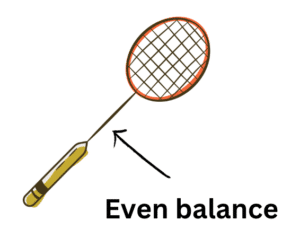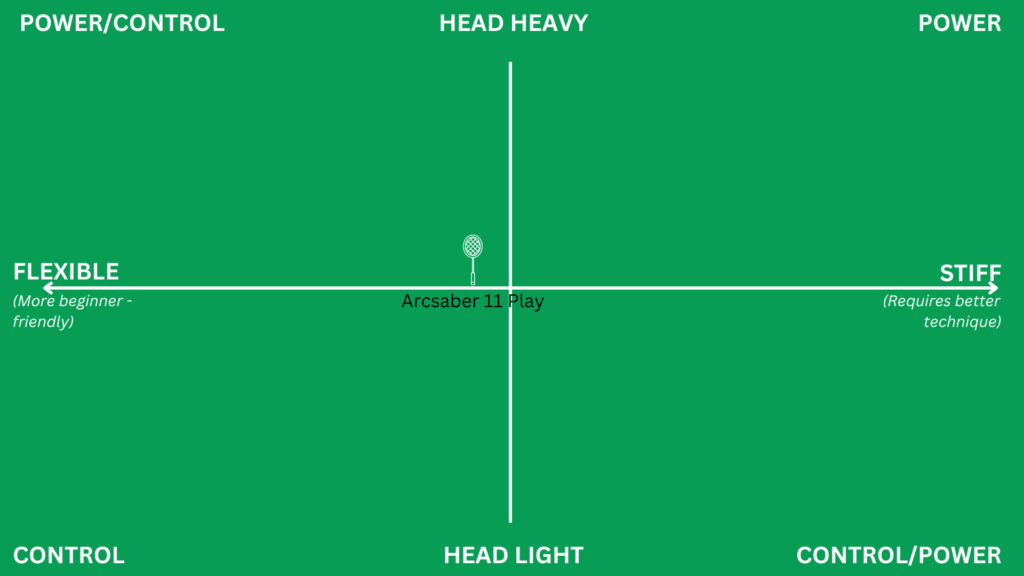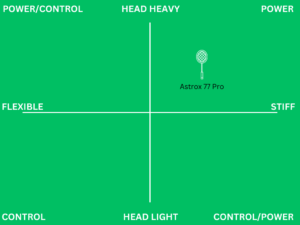THIS GUIDE HAS RECEIVED 3 UPDATES. THE LAST WAS MADE ON 12TH MARCH, 2025
- I rearranged the racket groups to include more categories
- The racket recommendations were updated
I recently needed a new weapon of choice. I wanted a head-heavy racket again, but I ended up getting interested in almost even balance badminton rackets instead, as all the other options on my shortlist were sold out.
I was pleasantly surprised as I’ve noticed getting almost the same power in all my shots across the board, except raw smash power that I now have to work a little harder to produce.
Instead, my drives and net shots are easier and faster. It’s a great trade-off in doubles where smashing a winning point tends to be less game-defining and mid-court exchanges are more frequent.
If I had to put a number on it, I’d say I lost three attribute points in “easily accessible” raw smash power but gained five points in the rest of my game. The total sum feels higher and has made it easier to play a more powerful, diverse game to win points.
When I switched rackets, I mostly feared for my blocks as my previous racket could produce awesome power blocks with little effort that just “crawled” over the net to cause problems for the opponents. It’s hard not to lose a bit of that when you give up the sledgehammer but it’s not as bad as I feared.
On the other hand, I’ve been surprised at how good my drop shots feel. With my previous racket, it was almost as if I had too much power making drops difficult to control and land close to the net. Now I have to produce a bit of the power myself but the nuance allows for more control or precision.
That has made sequences such as smashing or half-smashing two-three times in a row followed by a drop shot more effective than before.
With the introduction out of the way, let’s dive into the best even balance rackets available right now followed by pointers on which playing style to use with these types of rackets.
- Rackets tested for this guide: 14
- Hours testing rackets on court: 140+ hours
- Updated: 12. March 2025
The best even balance badminton rackets right now
I figure that since you’ve been looking for an even balanced racket, you already know what they are but just to be sure we are on the same page:
Even balance badminton rackets are rackets with a balance point that isn’t towards the head or the handle but somewhere in the middle.

It is measured in balance points (BP) and for rackets to fall within this category, the balance point needs to fall between 285-295mm when measured from the bottom of the handle.
Hey reader, a quick interruption...
I’m experimenting partnering with webshops that sell badminton gear, like Amazon. I’ll include links to buy the gear I review and if you do, they’ll pay me a small commission. That doesn’t change your price and you’ll get more play-tested gear as a result but I thought it was fair to let you know.
As an Amazon Associate, I earn from qualifying purchases.
I appreciate your support,
Aske
Here’s an overview of the best even balance badminton rackets right now:
1. The beginner + low-intermediate favorite: Yonex Arcsaber 11 Play
2. The intermediate court controller: Yonex Arcsaber 7 Pro (or Tour)
3. The advanced player’s choice: Yonex Arcsaber 11 Pro (or Tour)
4. The almost-even-balanced-joker: Yonex Astrox 77 Pro
Let’s dive in!
Table of Contents
1. The beginner + low-intermediate favorite: Yonex Arcsaber 11 Play

Yonex’s Arcsaber 11 Play used to be my favorite racket for a long time and I still come back to it every once in a while if my primary racket is at the shop getting restrung.
The 11 Play has a touch of head weight, but only as little as you can get away with while still calling it an even balanced racket.
It’s great for regular “advanced” beginners and low-intermediate players: it’s slightly flexible, but without much head weight, it feels crisper than you’d expect (I’m guessing due to less head weight bending the racket during big swings.)
While it lacks raw smash power as even balanced rackets tend to do, it’s great all around the court and I’ve had no issues defending fast shots during intense doubles games.
If you want more details, check out my in-depth Arcsaber 11 Play review after testing it on court.
2. The intermediate court controller: Yonex Arcsaber 7 Pro

The Yonex Arcsaber 7 Pro is only available in the 4U weight class, meaning it’ll be more suitable as a doubles racket rather than for singles games. I haven’t had the pleasure of play-testing the Pro edition of this racket yet, but I’ve just tested the slightly more budget-friendly Arcsaber 7 Tour edition.
I understand that they are super similar and at about 30% lower price, so I chose the Tour even if the Pro is made of slightly better material and in Japan instead of Taiwan or China.
I’ve enjoyed playing with the Tour, and it feels like a nice upgrade from the Arcsaber 11 Play I’ve come to enjoy. The 7 Tour has a slightly stiffer shaft that feels crisper when connecting with the shuttle (but requires better technique as well).
Typically, the Tour and Pro editions require better stroke skills than I have, but Yonex’s 7-series skips the Game edition (usually for intermediate players) and makes the Tour and Pro closer to medium flex than super stiff.
It has a touch less head weight and power than the 11-series, but it isn’t much. Check out my in-depth review of the Arcsaber 7 Tour here.
3. The advanced player’s choice: Yonex Arcsaber 11 Pro

The Yonex Arcsaber 11 Pro is the newer version of the older Arcsaber 11 and appears to be intended exactly as a middle-of-the-road racket by Yonex.
I haven’t been able to play-test the pro version yet, as I expect that my technique isn’t good enough to handle its stiffness. I recently tested out the intermediate edition called Arcsaber 11 Play and it was awesome, so if that’s anything to go by, the Pro will be even better.
It’s reported to offer a great combination of speed, control, and power without leaning too much in one direction. Net shots and lifts are good but if you’re looking for power in your smash or particularly speedy moves, this isn’t the racket for you.
This racket comes in different editions at different price points and for different skill levels; Play, Tour, and Pro.
4. The almost-even-balanced-joker: Yonex Astrox 77 Pro

Finally, I thought it would be fun to end with a joker. As you’ve guessed, it’s the new edition of the Astrox 77-series which is technically head-heavy, but just a tad.
The Tour and Pro models were sold out in shops near me, so I’ve only had the pleasure of reviewing and play-testing the Play-edition, the most affordable of them intended for beginners.
The reason I’ve included it is that it feels somewhat similar to an even balanced racket and is pretty great across the board. I found it easy to play with as I barely needed to adjust my technique.
Lengthy forehand clears were easy, and I felt more in control with drop shots compared to my previous, very head-heavy racket. Mid-court duels with flat drives felt easy along with blocking smashes and net shots.
These are the six attractive weapons if you’re looking for an even balanced badminton racket to help your game. Next, let’s look at which type of player and playing style tend to best suit this racket type.
The hidden power of even balance rackets and all-around players
Middle-of-the-road rackets are often overlooked compared to head-heavy or head-light rackets as they appear to have no special attributes, just like the equivalent player type.
We tend to love the idea of 2D player types like movie characters who have their signature move and are amazing at that but little else.
In contrast, being above average in all areas rather than amazing in one at the expense of another may sound boring on the surface but has a hidden benefit to it: you tend to make fewer mistakes and take fewer chances with your main attribute, such as a smash. That is surprisingly powerful in amateur games, where many points are lost on mistakes and off-days.
Since we amateurs don’t have the benefit of being able to train day in and day out, we have to maximize our energy and make do with whatever little time we have available. If we can play the game slightly safer than our opponents and push them to become tired or impatient, they will eventually make errors or take risky chances that we can capitalize on. That’ll make it easier for us to notice their weaker side and adapt, than for them to do it with us.
Most experienced players will be stronger than us in one area that they enjoy, so if we attempt to go head to head in that (i.e. smashing), we’ll run our head against a wall and they will come out on top.
Another benefit to all-around rackets (like the Yonex Arcsaber 11 Play) is that they tend to be forgiving with high playability. That means we won’t get punished as much on off days as we might by other types of rackets.
This is powerful because consistency is so important. Imagine playing well during a social or training session but when an important match comes along, you hit an off-day and play worse than you know you can. It almost doesn’t even seem fair. If we can get a little help on off-days when we feel inconsistent, it’ll go a long way to help pick up our mindset and get out on top.
Takeaways
- The best even balance badminton rackets tend to be great at everything except raw smash power, which you might not notice unless you’re switching from a sledgehammer or a very head-heavy racket
- These rackets tend to score above average in most categories, which is a skill in itself that is often overlooked
- An even balanced badminton racket is often highly playable and easy to use which is great on off-days to avoid inconsistent games
10 comments
hi aske, I was wondering if you could recommend so rackets for low intermediate players as the previous list you had about them are a little outdated or discontinued.
Hi Bob,
Thanks for pointing that out, I’ve been meaning to update that article.
It’s difficult to give a really specific suggestion for you since I don’t know much about your game or your preferences. Do you know what you’d like your racket to do for you?
If you aren’t sure, I’ve found the Yonex Astrox 77 Play to be a good all-around racket for me as a low-intermediate player in doubles games (I’ve only played with the 4U though).
It’s a bit too flexible for my liking as I sometimes mistime shots that I normally wouldn’t with my previous slightly stiffer racket. Depending on your budget, you could potentially take chance on it since it’s affordable and then upgrade to the tour or pro version if you’re in the same situation as me (they are in the medium stiff range).
I was most interested in the Astrox 6 that was recommended, do you have any rackets that fit the same style? or maybe something like the Arcsaber 11 play .
Thank you for replying. I really appreciate it
I should point out that I made an error in my article saying that the Astrox 6 is slightly stiff when in fact, it’s a flexible racket. Sorry.
The Arcsaber 11 Play is within the same arena, although slightly less head heavy and more middle-of-the-road (meaning less help with raw power) than the Astrox 6. It’s also less flexible than the Astrox 6, which will be a matter of preference for you – I like a medium-flexible racket like the Arcsaber 11 Play as opposed to one that’s more flexible but you might feel different.
The Astrox 77 Play, Astrox 88D Play, and Astrox 88S Play are similar in head weight to the Astrox 6. All the Play-rackets are within the same price range as well (at least here in Vietnam).
I hate that this is a factor, but it might come down to what the stores have in stock near you. If you’re most interested in the Arcsaber 11 Play, but want to more power, another alternative is to get it restrung with strings that offer more power.
Which racket do you play with now, and is there something you like or dislike about it?
I actually went through a few rackets now, I have been on the Astrox 38s > Astrox 88D Pro > ArcSaber 11 Play > ArcSaber 11 Pro.
I guess the reason why I bought a Astrox 88D Pro was because I previously believed that buying the best racket on the market and just sticking to it would improve my game. However I realized that I never really tried if I liked a even balance racket or head light etc. Hence the swap to Arc 11 Play. For the Arc 11 Play, I don’t really have much complains but that it doesn’t feel as powerful as the 88D Pro and that it feels abit more hollow. For now I’m on the Arc 11 Pro but I’m just worried if I just trying rackets that aren’t suitable for low intermediate players etc.
I agree with your logic around the Astrox 88D Pro and sticking with one racket to improve your game as you get to know it better.
It’s a stiff racket that on paper, at least, might be tricky to get the full use of if you don’t train your technical stroke skills regularly and fall into the low intermediate level. The same goes for the Arcsaber 11 Pro.
Of those rackets you mentioned, on paper, the Arcsaber 11 Play would be the most suitable for you, but in my humble experience, the reality isn’t always the same as on paper. I had a semi-stiff racket before that worked so well with me that whenever I used it, other players commented that my game had improved.
If I were you, I’d go with the one that feels the best when you play and makes things the easiest for you.
You mention that the Arcsaber 11 Play doesn’t feel as powerful as the 88D Pro. Do you tend to score lots of points with power shots like smashes or is it because you like the feeling of a good power shot, like me?
Perhaps the 88D Game would be a good fit – it seems like it might, at least on paper, as it’s more suited for players in the low-intermediate neighborhood.
Hmm i see i see thank you so much for your insights, I guess i was pretty used to a head heavy racket, that’s why it felt like the arcsaber didn’t have enough power. And yes i enjoyed playing power shots haha. In your opinion , if i already have the Arc11 Pro and Play, should i stick with them in order to figure out if i like a HH racket more ? Or should i try the 88D game and see if i enjoy it
Haha – I enjoy playing power shots too.
Regarding the rackets, only you can make that decision as it depends on if you prefer to spend money on another racket, or if you’d rather practice techniques that can deliver more power with the Arcsaber 11s. There’s nothing right or wrong as it’s a matter of preference but there is a chance that you won’t like the Astrox 88D Game. Any chance you know someone with the 88D Game that you could borrow for a game to get a better feel for it?
Hey Aske,
I am an intermediate player and play with Arcsaber 8 power . I wanna buy another similar racket and confused between Arcsaber 7 tour and Arcsaber 11 play.
I mostly play doubles.
What racket do you suggest ?
Hey Rajat, I’m not familiar with the Arcsaber 8 power, but if you’re an intermediate player I imagine you’ll feel the 11 play too flexible and prefer the 7 tour